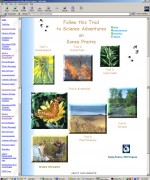A new feature on the Konza LTER website features data collected and input by SLTER students. The students and their teachers participate in insect and plant inventories and input the data to a central location via the World Wide Web. The results are featured on the new "Science Adventures" section of the Konza web site (visit the website at: http://www.ksu.edu/konza/keep).
Funding for these additions to the web site is from a Dwight D. Eisenhower Professional Development Program administered by the Kansas Board of Regents.
Konza Prairie education coordinator Valerie Wright also is working with scientists to make LTER data available to the young researchers in the SLTER program. "We've done two LTER data sets so far-insect galls and grasshoppers," Valerie says. "It's a lot of work to go through the data and see how much -or how little-we can actually use. It has really made me consider the usefulness of data, and the importance of 'meta' data [data about data]. Sometimes it's impossible to understand the data, let alone make it usable for schoolteachers.
"But when we do, the teachers love it. They appreciate it so much. And they pass it on to math teachers and social studies teachers, too."
On the new website, each 'trail' represents a science activity. Valerie leads the teachers and students through the activities at the Prairie, and the students input the data they collect in the activities through the website.
The most recent data was collected during this fall's insect inventory, using sweep nets. "Each year the kids come up with a new specimen, and this year we caught one that has no common name, so they'll come up with their own common name," Valerie says.
The young scientists add their data remotely from classroom. "At times there are glitches with the online system, but it's getting better," Valerie says.
The project includes 17 teachers and their students. Teachers complete a training program before incorporating the activities into their curricula.
The teachers love it, Valerie says. "They love the hands on stuff, especially. So do the students, because they know we are interested in their data and they get to see what happens to it."

 Enlarge this image
Enlarge this image